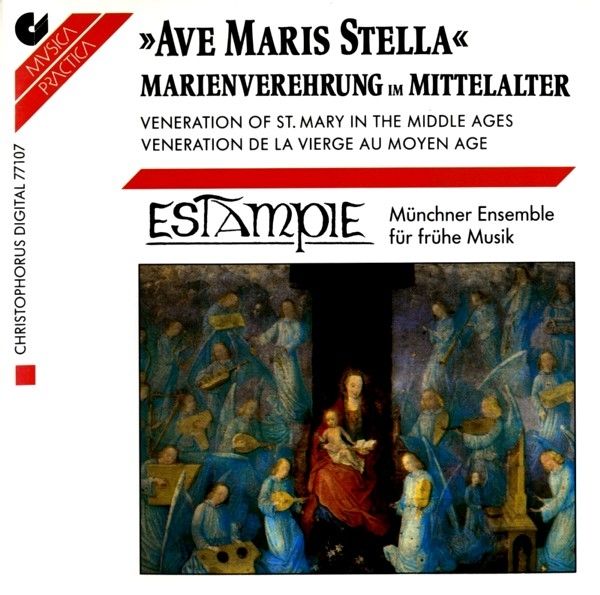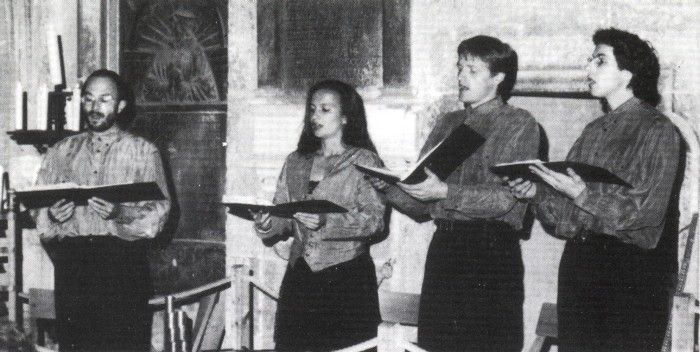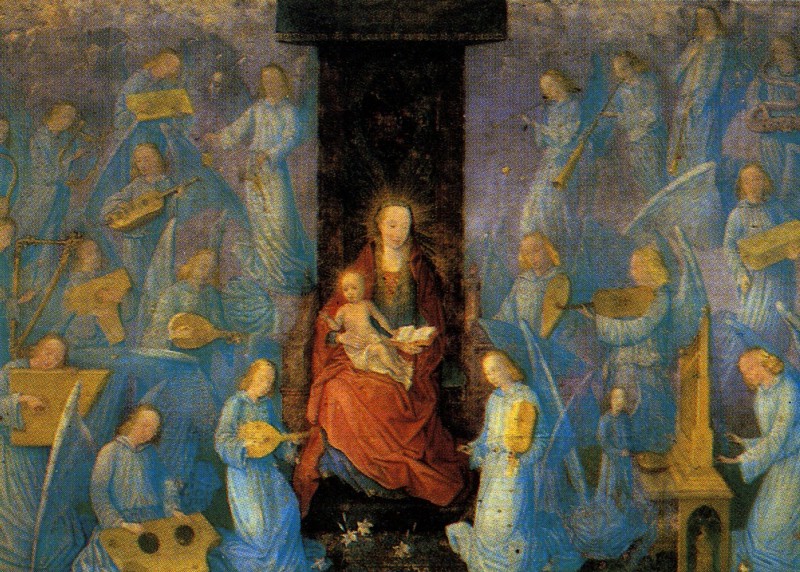Ave maris stella / Estampie
Marienverehrung im Mittelalter · Veneration of St. Mary in the Middle Ages

medieval.org
Christophorus "mvsica practica" CHR 77 107
1991
1. Ave maris stella [2:20]
Zisterzienser Hymnar, Heiligenkreuz
Gesang
2. Ave generosa [4:46]
Hildegard von BINGEN
Gesang, Portativ, Ud
3. Ave mater, o Maria [2:48]
Oswald von WOLKENSTEIN
Gesang, Portativ
4. Stabat juxta Christi crucem [4:02]
Codex Las Huelgas Hu 61
Ud, Organistrum, Gemshorn, Percussion
5. Ave, donna santissima [3:56]
Laudario di Cortona
Gesang, Ud, Drehleier, Percussion
6. Dansse real [5:54]
Codex »Paris fr.844«
Tar, Drehleier, Santuri, Flöte
7. Regenbogen tagewise [8:16]
Colmarer Liederhandschrift
Gesang, Tar
8. Saltarello [4:28]
Codex London BM add.29987
Ud, Drehleier, Flöte, Percussion
9. Humils, forfaitz, repres e penedens [5:04]
Guiraut RIQUIER
Gesang, Harfe, Organistrum, Percussion
10. Vos qui admiramini [2:55]
Philippe de VITRY
Gesang, Flöten
11. Ave gloriosa, mater salvatoris [1:25]
Codex Cividale
Gesang
12. Santa Maria, strela do dia [5:28] Cantigas de Santa Maria
CSM 100
Gesang, Tar, Drehleier, Santuri
13. Da que deus mamou [5:57] Cantigas de Santa Maria
CSM 77
Gesang, Saz, Portative, Flöte, Percussion
14. Ave maris stella [1:14]
Codex Faenza 117
Portativ, Laute
15. Stella splendens [5:29] Codex Llibre Vermell
LV 2
Gesang, Ud, Portativ, Glocken, Percussion

Ernst Schwindl · Sigrid Hausen · Michael Popp · Johann Bengen
ESTAMPIE
Münchner Ensemble für frühe Musik
Sigrid Hausen — Gesang, Flöte, Gemshorn
Michael Popp — Ud, Saz, Tar, Harfe, Flöten
Ernst Schwindl — Drehleier, Organistrum, Portativ, Glocken
Johann Bengen — Santuri, Percussion
als Gast:
Mona Spägele — Gesang
ESTAMPIE
the ensemble for Early Music from Munich, was founded in 1985 bySigrid
Hausen, Michael Popp and Ernst Schwindt. In the meantime the
percussionist Johann Bengen belongs to the permanent cast.
The
ensemble strives to make the music of the Middle Ages from ca 1000-1400
an interesting experience for the today's listener. This music is
characterized by strange tonal pictures, the most diverse texts
depicting the medieval world of feelings and a clear formal language
whose beauty is developed in various musical structures. For the
musician, the essential task becomes to absorb himself creatively in
compositions which often are notated merely in a rudimentary fashion.
Building on fundamental knowledge regarding instrumentation,
rhythmization and harmonization, each music piece is created in an
individual manner only through tonal imagination, arrangement and
sensitive improvisation.
ESTAMPIE has played on several
occasions, including during the course of the Flanders Festival, the
Dollart Festival, the FAMM Concert Series and the Landshuter
Hofmusiktage. In addition to concerts through Germany, Holland, Belgium
and Switzerland, the ensemble has also performed on radio and
television. In April 1987 ESTAMPIE won the Second International
Competition for Early Music in Amersfoort (Holland).
Coproduction with Süddeutscher Rundfunk Stuttgart / SDR
Recording: Süddeutscher Rundfunk, 11./16./17.7.1990
Recording Producer: Andreas Priemer
Recording Engineer: Christian Leuschner
Cutting: Brigitte Burgess
Cover Picture: "Celestial Music" (Anonymous XV century), Museo de Bellas Artes de Bilbao
Cover Design: Manfred Glaser/Herbed Becker
℗ 1990 © 1991 MusiContact GmbH, Heidelberg, Germany

VENERATION OF ST. MARY IN THE MIDDLE AGES
Although
the evangelists attached little importance to the historical Virgin
Mary, the woman from Nazareth, nevertheless in the course of time an
intensive and complex cult developed around her. Because of certain
historical factors,this cult was able to acquire various aspects.
Mary was worshipped by Christians in the Middle Ages in four different respects:
– as mater dolorosa lamenting the death of her son and the Saviour and thus all the evil of the world;
– as regina coeli, terrae et maris, the divine, honourable queen with crown and sceptre;
– as auxiliatrix, a friend in need, pleading to Christ for all the sinners or doing great deeds;
– as virgo, the untouched, pure virgin, standing as the model picture of the middle-aged woman and mistress.
There
are numerous further titles and descriptions corresponding to these
four aspects of the cult around the Virgin Mary, for example, ancilla dei, stella maris, generosa, splendens (in one song of a minnesinger even 72 expressions are used!). The four categories dolorosa, regina, auxiliatrix and virgo
can more or less be fitted to four musical genres, that is the planctus
(the lament), the song of praise, the tale of the miracle (especially
in the "Cantigas de Santa Maria") and the spiritual minnesong.
(Translation by Barbara Clark)

(1) AVE MARIS STELLA
At the beginning of the recording we have the hymn Ave maris stella.
The
"sea-star" lights the way for the sailors just as it symbolically
accompanies the faithful on their journey of life. In the Christian
veneration of St Mary we can find many aspects of pre-Christian
matriarchal cultures. For example, the "Venus-Star" already became a
symbol of the sea and during the high-culture of Crete seamanship.
(2) AVE GENEROSA
Hildegard
von Bingen is the first female composer we know by name who although
was well-known for her mystical visions. Most of the important
personalities of the day, emperors and popes, kept in touch with her.
She was imbued with the idea of an universal divine harmony. Therefore
she saw her compositions as "symphonies harmoniae caelestis" as the
revelation of heavenly harmony.
In the piece Ave generosa Mary is worshipped as the untouched pure virgin and her chaste, divine marriage is praised euphorically
(3) AVE MATER, O MARIA
Oswald von Wolkenstein, lord of the castle and diplomat, is the last of the medieval minnesingers.
On
his journeys round Europe he also got to know polyphonic works of music
in ltaly and France and then used the musical form of a four-part laude
for his work of poetry Ave mater, o Maria.
(4) STABAT JUXTA CHRISTI CRUCEM (instrumental)
The
Cistercian monastery Las Huelgas near Burgos was one of the main places
of cultivation of polyphonic music on the Iberian peninsula in the
Middle Ages. The manuscript contains the repertoire of polyphonic songs
used in Las Huelgas which replaced the monophonic choral melodies on
special occasions.
Stabat juxta Christi crucem is an instrumental work about Mary's lament under the cross, a planctus.
(5) AVE, DONNA SANTISSI MA
Ave, donna santissima is a religious song with folklore characteristics, a so-called lauda The composing of laudi
has its roots in the devoutness of the people which was aroused by
Francis of Assisi and which stood in conscious opposition to the
official church.
In this song of praise Mary's immaculate conception
is sensitively compared to the rays of the sun which appear as a shining
beam in a water glass without actually touching the water In the same
way Jesus Christ installs himself in Mary's virgin body.
(6) DANSSE REAL (instrumental)
(7) REGENBOGEN TAGEWISE
Regenbogen tagewise
is a piece of popular poetry which the minnesinger Regenbogen included
in his repertoire. This piece found its way into the Colmar volume of
song manuscripts, one of the last collections of the songs of the
minnesingers from the whole of the Middle Ages.
The "Tagewise"is a
reconstruction of a secular morning song, which normally portrays the
morning departure of the lover from his sweetheart, in a religious text.
This was a common practice in the Middle Ages. The theme of this song
is the prophecy and Passion of Christ, transferred however to a courtly
setting with God appearing as a prince and Mary as a noble virgin.
(8) SALTARELLO (instrumental)
(9) HUMILS, FORFAITZ, REPRES E PENEDENS
Guiraut
Riquier was the last great Provençal troubadour. After the almost
complete destruction of the culture in the South of France during the
Albigensian crusades, the musicians were forced to look for new fields
of activity in the surrounding regions. Guiraut himself found
accomodation for the next decade with the art-loving King Alfonso X el
Sabio in Spain. The art of the troubadours was nearing its end however
and Guiraut himself expressed in one of his songs: "I came too late."
In his song of the Virgin Mary called Humils, forfaitz, repres e penedens
he turns to Mary, humbly and penitently because of his sins. He sees
her as his last hope in his despair and calls to her: "For us, Lady
royal Virgin, you became the mother of the son of God the Almighty: Ask
Him for guidance for us!"
(10) GRATISSIMAVIRGINIS SPECIES
.
Philippe
de Vitry was regarded as a musical revolutionary in his time. He not
only developed a musical notation which has fundamentally been preserved
up to the present time, but also helped the musical forms motet,
ballad, virelai and rondeau to the significance which they were to have
for a long time. He also attempted to remove his musical activities from
any sort of specific purpose, whether it be of a religious or of a
courtly nature.
Gratissima virginis species is a a
double-texted motet over a two-part tenor which is performed
instrumentally. Both texts deal equally with the adoration of the Virgin
Mary.
(11) AVE GLORIOSA, MATER SALVATORIS
The two-part trope Ave gloriosa, mater salvatoris
is a piece of work taken from the Friulian Codex Cividale. The record
of it in twelve other sources proves the great popularity of this work.
The line of melody has been kept very simple, both parts run parallel to
each other in consonance. This work was composed particularly for the
Virgin Mary's birthday on 8th September and includes an invocation to
Mary under her various epithets.
(12) SANTA MARIA, STR ELA DO DIA
The
"Cantigas de Santa Maria"are included in one of the most extensive
manuscripts of music from the Middle Ages. The extremely art-loving King
Alfonso (the wise one) had this magnificent anthology put together.
Apart from songs of praise, there are also tales of miracles contained
in this collection. The composers of the melodies were partly the King
himself and also the numerous troubadours who were present at this
court.
"Holy Mary, star of the day show us the way to God and guide us" is the chorus of the song of praise Santa Maria, strela do dia.
(13) DA QUE DEUS MAMOU
Da que Deus mamou
tells of one of the numerous miracles which Mary was supposed to have
performed: Various doctors predict that a sick woman will soon die. Full
of despair she calls upon Mary who orders her to be carried in front of
the Church of Santa Maria de Lugo and to continue praying fervently.
After several days a miracle takes place and the woman who was so close
to death is healed before the eyes of the people and the Bishop.
(14) AVE MARIS STELLA (instrumental)
The
Codex Faenza contains the largest collection of instrumental music
preserved from the Middle Ages. The 48 two-part pieces are all developed
as diminuitions of songs and dances which were well-known at the time. Ave maris stella takes up the hymn from the beginning which can be heard in the lower part, while a newly composed upper part rings out.
(15) STELLA SPLENDENS
The
"Llibre Vermell" is a manuscript from the monastery of Montserrat. The
monks of Montserrat saw in the unusual mountain, upon which their
monastery is placed, an image of the Virgin Mary. The Madonna of
Montserrat - called "moreneta" which means the small black one - was,
according to a legend, brought by an angel on to a field and found there
by shepherds. The brisk Stella splendens describes the
pilgrim train of the faithful up to the Moreneta: "Bright star on the
mountain, like a ray of sun full of miracles, listen to the people. They
all hasten here joyfully poor and rich, young and old. Princes and
magnates of royal blood, the powerful of the world, prelates and barons
with noble entourage, monks, priests, soldiers peasants, scribes and
advocates confess their sins full of repentance and call, on bended
knees: Ave Maria".



